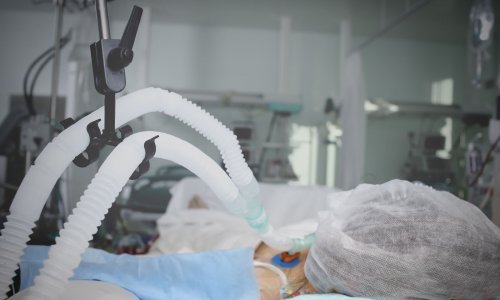Reducing breath size and pressure from ICU ventilator increases long-term survival in people with acute lung injury
-Lung-protective mechanical ventilation needs greater utilization, researchers say
Carefully adjusting mechanical ventilator settings in the intensive care unit to pump smaller breaths into very sick lungs can reduce the chances of dying by as much as 8 percent, according to a study by critical care experts at Johns Hopkins. Study participants were evaluated for two years after their acute lung injury.

“Adjusting the ventilator to keep the breath size and lung pressures lower can have a dramatic effect on whether or not a patient dies from their lung injury, even long after they leave the ICU,” says lead study investigator and critical care specialist Dale Needham, M.D., Ph.D. “People with acute lung injury are very sick and often in the hospital for weeks, not days.”
The Johns Hopkins team’s latest findings, to be published in the British Medical Journal, online March 27, come from evaluating the ventilator settings and subsequent survival or death of some 485 men and women, most over 50, spending at least a week or more in intensive care at four Baltimore-area hospitals. All had life-threatening acute lung injury.
In what is the most comprehensive study evaluating the long-term effects of mechanical ventilation on acute lung injury patients, researchers found that over the entire ICU stay, on average, for every one unit increase in the ventilator setting – known as tidal volume, calculated in milliliters per kilogram of predicted body weight of the patient – there was a commensurate 18 percent jump in the risk of mortality over two years, a finding which Needham says, “represents a huge difference” and reinforces the message to critical care specialists to keep tidal volumes and lung pressures adherent to known lung-protective ventilator settings. Previous research had shown that using lung-protective ventilator settings reduced inflammation and decreased the amount of time that other vital organs, such as the heart and kidneys, were not functioning normally. Short-term survival rates also improved.
Needham says that in people with acute lung injury, including acute respiratory distress syndrome, larger breath sizes put more stress on the lungs because only a small portion of healthy tissue is available to service the body’s oxygen needs. “Using a smaller breath size simply places less stress on the lungs,” says Needham, an associate professor at the Johns Hopkins University School of Medicine.
Mechanical ventilators are medical devices that deliver oxygen-rich air, under increased pressure, through a tube from the patient’s mouth into their lungs to help them breathe, and are used when patients’ lungs are too sick to adequately function on their own.
Among the researchers’ other key findings were that only 41 percent of the 6,240 ventilator settings reviewed in the study were adherent with lung-protective ventilation, using smaller breaths and reduced pressure.
“Our study shows there is still a lot of room for improvement in how we treat acute lung injury in the ICU,” says Needham, who points out that one of the biggest barriers to fixing the problem is a lack of understanding of the best methods for having ICU staff quickly recognize acute lung injury and change their traditional practice to adopt lung-protective ventilation.
Another barrier is miscalculating the correct tidal volume setting, as the formula is based on predicted body weight instead of actual body weight. Estimates show that as many as two-thirds of ICU patients are overweight, which has no bearing on physical lung size. People who are the same height and gender will have similarly sized lungs, even if one weighs significantly more than the other.
“Such details can have lasting effects,” says Needham. “Critical care practitioners have to refocus our efforts on not simply getting patients out of the ICU alive, but on changing traditional medical care in the ICU to improve patients’ recovery over the longer term.”
Experts say the chances of dying from acute lung injury (ALI), as caused by pneumonia, aspirating food or drink into the lungs, major trauma or near drowning, are already high, due to the resulting widespread inflammation and destruction of lung tissue. Of the estimated 190,000 Americans who suffer from ALI each year, more than 74,000, almost 40 percent, will die while in hospital, and 60 percent are likely to die within two years of their respiratory event.
All study participants were treated in ICUs at either The Johns Hopkins Hospital, Johns Hopkins Bayview Medical Center, University of Maryland Medical Center, or Baltimore Veterans’ Affairs Medical Center.
Needham says his team’s next steps are to assess quality of life for several years after patients have left the ICU to better understand any additional effects of lung-protective ventilation.
Funding support for the study was provided by the National Institutes of Health and the Canadian Institutes of Health Research.
####
In addition to Needham, other Johns Hopkins researchers involved in this study were Elizabeth Colantuoni, Ph.D.; Pedro Mendez-Tellez, M.D.; Victor Dinglas, B.S.; Jonathan Sevransky, M.D., M.H.S.; Cheryl Dennison Himmelfarb, R.N., Ph.D.; Sanjay Desai, M.D.; Roy Brower, M.D.; and Peter Pronovost, M.D., Ph.D.
18.04.2012











